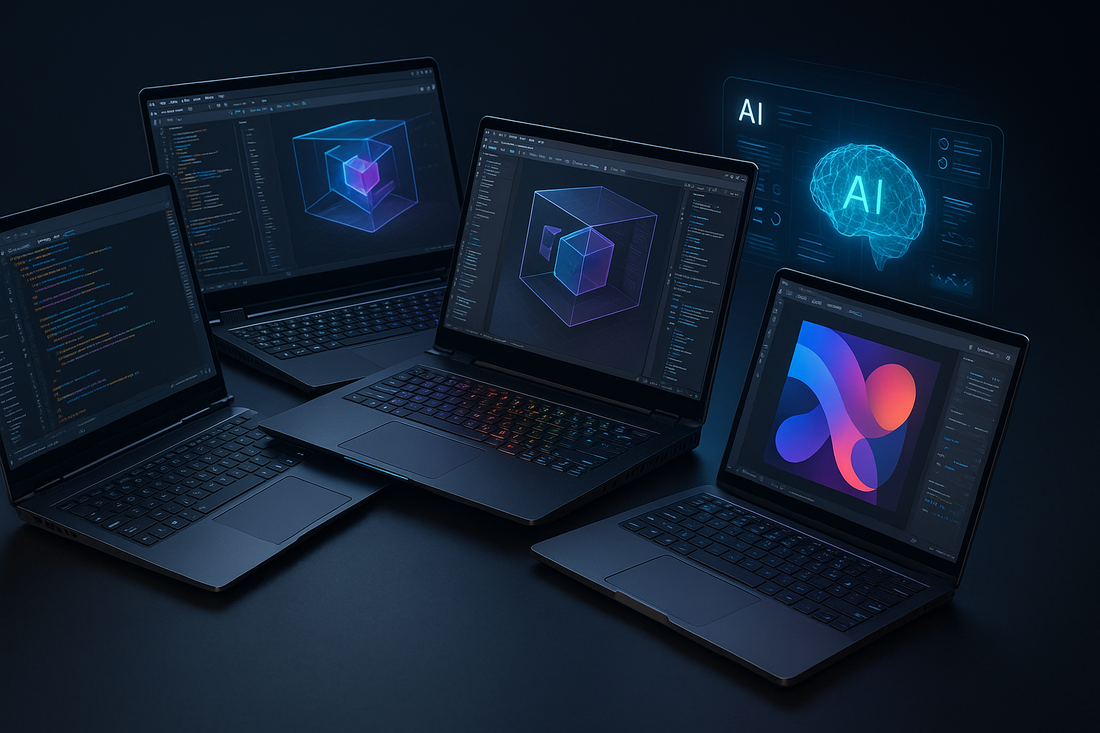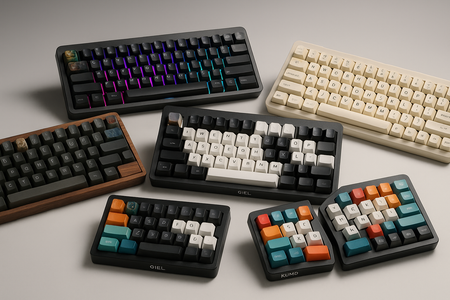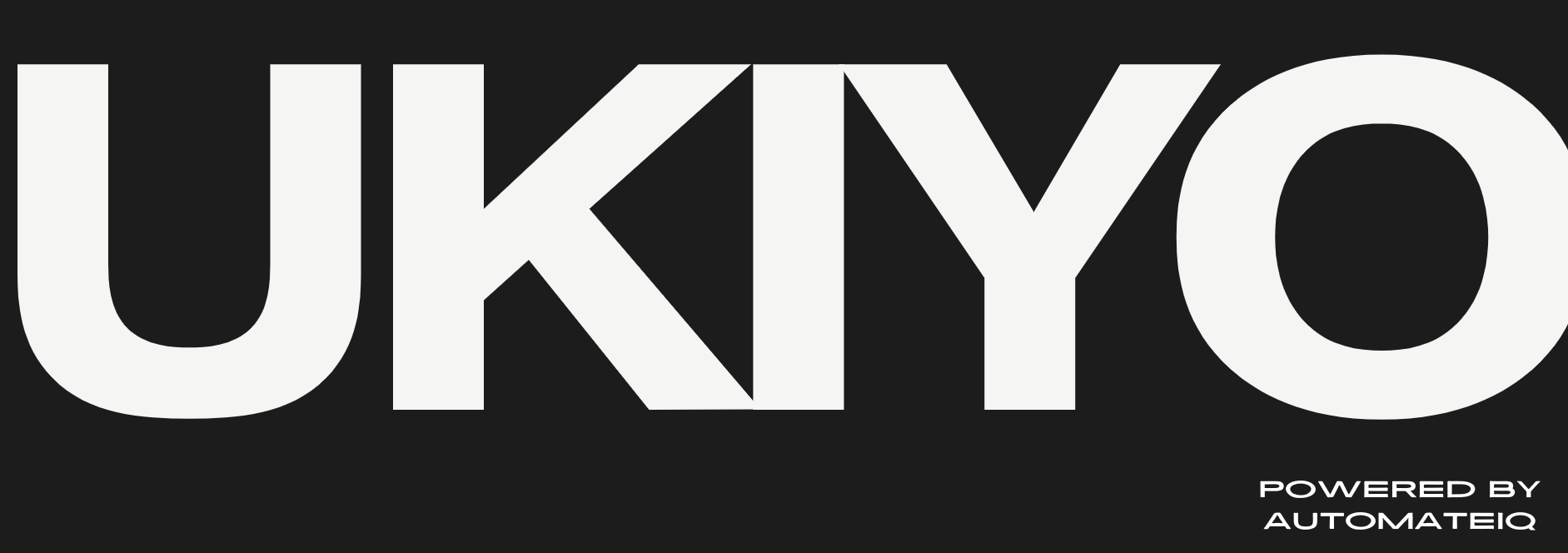Artificial intelligence has become a central part of professional workflows—especially for designers, developers, and data scientists. Whether you’re training a machine learning model, editing 8K video, or creating real-time 3D animations, having an AI-ready laptop is crucial. Gone are the days when only bulky desktop workstations could handle advanced GPU compute tasks. In 2025, laptops now boast specialized accelerators, top-tier CPUs, and forward-thinking design to accommodate AI workloads on the go.In this guide, we’ll explore the best laptops 2025 has to offer for creative and coding professionals. Each pick features high-performance hardware, next-generation graphics, and unique advantages tailored to machine learning mobile workstations.
1. Apple MacBook Pro 18 (M6 Max)
Key Specs
- Processor: Apple M6 Max (12-core CPU + 36-core Neural Engine)
- Graphics: Integrated 16-core GPU plus dedicated ML accelerators
- RAM: 32 GB or 64 GB unified memory
- Storage: 1 TB–4 TB NVMe SSD
- Display: 16.5-inch Liquid Retina XDR, 120Hz ProMotion
- Approx. Price: Starts at $3,499
Performance Apple’s MacBook Pro line has dominated the creative space for years, and the 2025 iteration cements its position for AI use cases. The Neural Engine now sports a dedicated matrix multiplier block, speeding up tasks like text-to-image generation, voice recognition, and real-time video upscaling. Meanwhile, the integrated GPU and advanced memory architecture seamlessly handle massive scenes in software like Final Cut Pro and Blender.Pros
- Unified memory design ensures minimal bottlenecks
- Exceptional battery life (up to 14 hours in AI inference tasks)
- Industry-leading color accuracy on the XDR display
- Quiet thermal design for heavy workloads
Cons
- Limited to macOS ecosystem, which can affect some ML frameworks
- Expensive upgrades for higher RAM or storage configurations
- Fewer dedicated GPU options than competing Windows laptops
Verdict For professionals already invested in Apple’s ecosystem—especially those doing video editing, 3D rendering, or iOS-specific development—the MacBook Pro 18 (M6 Max) is a powerhouse. Its AI-powered image processing capabilities shine with native apps, though heavier multi-GPU tasks may be better served by a dedicated discrete GPU on another platform.Internal Resource: Want more synergy with an automated workspace? Check out our Beginner’s Guide to Smart Devices to see how Apple’s hardware integrates into a broader connected environment.
2. Lenovo ThinkPad P1 G8 AI
Key Specs
- Processor: Intel Core i9-15900H (8 Performance + 8 Efficiency cores)
- Graphics: NVIDIA RTX 5090 Mobile (16 GB GDDR7), Tensor and RT Cores
- RAM: Configurable up to 128 GB DDR5
- Storage: 1–8 TB PCIe Gen5 SSD
- Display: 16-inch 4K OLED, 100% DCI-P3
- Approx. Price: Starts at $3,299
Performance Lenovo’s ThinkPad P Series has a legacy in workstation reliability, and the P1 G8 AI continues that trend. The highlight here is an RTX 5090 Mobile GPU that brings top-tier ray tracing and a large number of Tensor Cores for AI computations. This rig is perfect for training smaller ML models, performing real-time denoising, or running complex code builds quickly.Pros
- Robust build quality with magnesium-aluminum chassis
- Expandable memory for large-scale data sets
- ThinkPad keyboard renowned for comfortable typing
- Advanced thermal management for sustained loads
Cons
- Bulkier and heavier than consumer ultrabooks
- High-end configurations can exceed $5,000
- Battery life lags behind MacBook Pro or ARM-based competitors
Verdict A prime choice for enterprise-level AI tasks and advanced 3D design, the Lenovo ThinkPad P1 G8 offers a balanced approach: a robust GPU plus workstation certifications for engineering software. If your workflow demands Windows-based machine learning or specialized tools (MATLAB, CAD, etc.), you’ll appreciate this laptop’s flexibility and high-performance portable hardware.External Reference: For detailed benchmarks, see LaptopMag’s review of the ThinkPad P1 G8 to evaluate how it stacks up in real-world tests.
3. Dell XPS 17 AI Edition
Key Specs
- Processor: Intel Core i7-15900 or i9-15900 option
- Graphics: NVIDIA RTX 5070 or 5080 Mobile (up to 12 GB VRAM)
- RAM: Up to 64 GB DDR5
- Storage: 512 GB–4 TB PCIe Gen5 SSD
- Display: 17-inch InfinityEdge 4K UHD+, 500-nit brightness
- Approx. Price: Starts at $2,499
Performance Dell’s XPS line emphasizes a sleek form factor without sacrificing power, and the XPS 17 AI Edition is no exception. It includes optional AI co-processors built into the GPU for edge computing tasks and real-time AI-based optimization—like background noise elimination, advanced color calibration, and even automatic fan curve adjustments.Pros
- Slim profile for a 17-inch powerhouse
- Thunderbolt 5 ports for external GPU or docking expansions
- Excellent audio output for a laptop, tuned for content consumption
- AI-based battery optimization extends usage during moderate tasks
Cons
- Less VRAM compared to professional workstation GPUs
- Heat dissipation can be challenging under extreme loads
- 17-inch size is less portable than 15- or 14-inch alternatives
Verdict For designers who value a large, color-accurate display and developers seeking a semi-mobile AI workstation, the Dell XPS 17 hits a sweet spot. The advanced GPU options handle moderate ML tasks comfortably, though if you need maximum VRAM for huge models, the ThinkPad P1 G8 might be a better fit.Internal Resource: If you’re handling complex corporate video or large-scale animations, refer to our Case Study on Corporate Video Campaigns to see how GPU horsepower speeds up post-production.
4. HP ZBook Firefly 16 AI
Key Specs
- Processor: AMD Ryzen 9 8850H (8 cores + dedicated AI engine)
- Graphics: AMD Radeon Pro 7900M (12 GB VRAM)
- RAM: Up to 64 GB DDR5
- Storage: Up to 2 TB PCIe Gen5 SSD
- Display: 16-inch IPS, optional HDR600
- Approx. Price: Starts at $2,099
Performance HP’s ZBook line targets creative professionals seeking reliable color reproduction and strong performance. The Firefly 16 AI variant uses an AMD CPU with integrated AI instructions, promising better synergy for machine learning tasks that rely on AMD’s proprietary frameworks. The Radeon Pro 7900M includes advanced ray accelerators for real-time rendering and robust compute cores for data parallel workloads.Pros
- Competitive pricing for specs offered
- AMD’s SmartShift AI dynamically balances CPU/GPU power
- Color-accurate display suits design workflows
- Solid battery life thanks to efficient AMD architecture
Cons
- Less third-party developer support for AMD-based AI frameworks
- Fewer high-end GPU config options than NVIDIA-based solutions
- Fans can get loud under sustained ML or rendering tasks
Verdict An excellent choice for those loyal to AMD’s ecosystem or seeking slightly lower price points. The ZBook’s design heritage ensures you’re getting a robust chassis and enterprise-friendly features. If you work with AMD-optimized pipelines or prefer open-source solutions, the HP ZBook Firefly 16 AI stands out as a strong competitor among laptops for designers and developers.
5. Razer Blade 18 AI Studio
Key Specs
- Processor: Intel Core i9-15900HK (unlocked)
- Graphics: NVIDIA GeForce RTX 5090 Mobile (20 GB GDDR7)
- RAM: Up to 128 GB DDR5
- Storage: Dual PCIe Gen5 SSD slots (RAID 0 capable)
- Display: 18-inch QHD+ 240Hz, 100% sRGB
- Approx. Price: Starts at $3,899
Performance Razer’s gaming laptops have historically doubled as performance beasts for creative professionals. The Blade 18 AI Studio merges gaming pedigree with specialized drivers for content creation. The 20 GB of VRAM is a big plus for data scientists working with large neural net models or video editors dealing with 12K raw footage.Pros
- Premium unibody aluminum construction
- Configurable “Studio Mode” for stable, quiet performance during rendering
- QHD+ high-refresh display—ideal for motion design or gaming breaks
- Potential for RAID 0 high-speed storage arrays
Cons
- Pricey, especially with maxed-out specs
- Slightly heavier than standard 15- or 16-inch laptops
- Battery life below average if used for intense GPU tasks away from power
Verdict The Razer Blade 18 AI Studio appeals to users who need maximum GPU power in a portable form—like real-time VFX demos, heavy 3D modeling, or advanced ML training. It’s an all-in-one workstation/gaming rig if your budget can handle it.External Reference: For deeper performance metrics, see Tom’s Hardware’s laptop benchmark tests.
Conclusion: Matching AI-Ready Laptops to Your Workflow
In 2025, high-performance portable hardware has come a long way, blending AI acceleration with robust CPU/GPU specs. Your ideal pick depends on your daily tasks:
- Apple MacBook Pro 18 (M6 Max) if you’re deep in the Apple ecosystem and do heavy video editing or iOS dev.
- Lenovo ThinkPad P1 G8 AI for a robust Windows workstation with large VRAM and enterprise-level reliability.
- Dell XPS 17 AI Edition when you want a sleek form factor with strong GPU/CPU performance for design or code.
- HP ZBook Firefly 16 AI if you prefer AMD solutions and want a budget-friendly, color-accurate workstation.
- Razer Blade 18 AI Studio for maximum GPU grunt, combining gaming prowess with creative horsepower.
No matter your choice, these AI-ready laptops stand prepared for advanced tasks in machine learning mobile workstations. From deep learning experimentation to immersive design projects, your laptop is now a genuine partner in the creative and development process.Call to Action: Ready to make the jump? Evaluate your typical workload—3D modeling, raw 8K editing, or large-scale ML training—and pick the laptop that resonates with your performance and portability needs. Don’t forget to consult user reviews, check official spec sheets, and ensure the device’s synergy with your existing software ecosystem.






0 comments